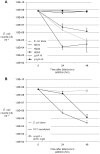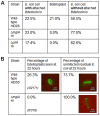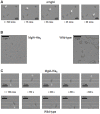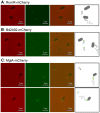Ras GTPase-like protein MglA, a controller of bacterial social-motility in Myxobacteria, has evolved to control bacterial predation by Bdellovibrio
- PMID: 24721965
- PMCID: PMC3983030
- DOI: 10.1371/journal.pgen.1004253
Ras GTPase-like protein MglA, a controller of bacterial social-motility in Myxobacteria, has evolved to control bacterial predation by Bdellovibrio
Abstract
Bdellovibrio bacteriovorus invade Gram-negative bacteria in a predatory process requiring Type IV pili (T4P) at a single invasive pole, and also glide on surfaces to locate prey. Ras-like G-protein MglA, working with MglB and RomR in the deltaproteobacterium Myxococcus xanthus, regulates adventurous gliding and T4P-mediated social motility at both M. xanthus cell poles. Our bioinformatic analyses suggested that the GTPase activating protein (GAP)-encoding gene mglB was lost in Bdellovibrio, but critical residues for MglA(Bd) GTP-binding are conserved. Deletion of mglA(Bd) abolished prey-invasion, but not gliding, and reduced T4P formation. MglA(Bd) interacted with a previously uncharacterised tetratricopeptide repeat (TPR) domain protein Bd2492, which we show localises at the single invasive pole and is required for predation. Bd2492 and RomR also interacted with cyclic-di-GMP-binding receptor CdgA, required for rapid prey-invasion. Bd2492, RomR(Bd) and CdgA localize to the invasive pole and may facilitate MglA-docking. Bd2492 was encoded from an operon encoding a TamAB-like secretion system. The TamA protein and RomR were found, by gene deletion tests, to be essential for viability in both predatory and non-predatory modes. Control proteins, which regulate bipolar T4P-mediated social motility in swarming groups of deltaproteobacteria, have adapted in evolution to regulate the anti-social process of unipolar prey-invasion in the "lone-hunter" Bdellovibrio. Thus GTP-binding proteins and cyclic-di-GMP inputs combine at a regulatory hub, turning on prey-invasion and allowing invasion and killing of bacterial pathogens and consequent predatory growth of Bdellovibrio.
Conflict of interest statement
The authors have declared that no competing interests exist.
Figures







References
-
- Mahmoud KK, Koval SF (2010) Characterization of type IV pili in the life cycle of the predator bacterium Bdellovibrio . Microbiology 156: 1040–1051. - PubMed
Publication types
MeSH terms
Substances
Grants and funding
LinkOut - more resources
Full Text Sources
Other Literature Sources
Miscellaneous

